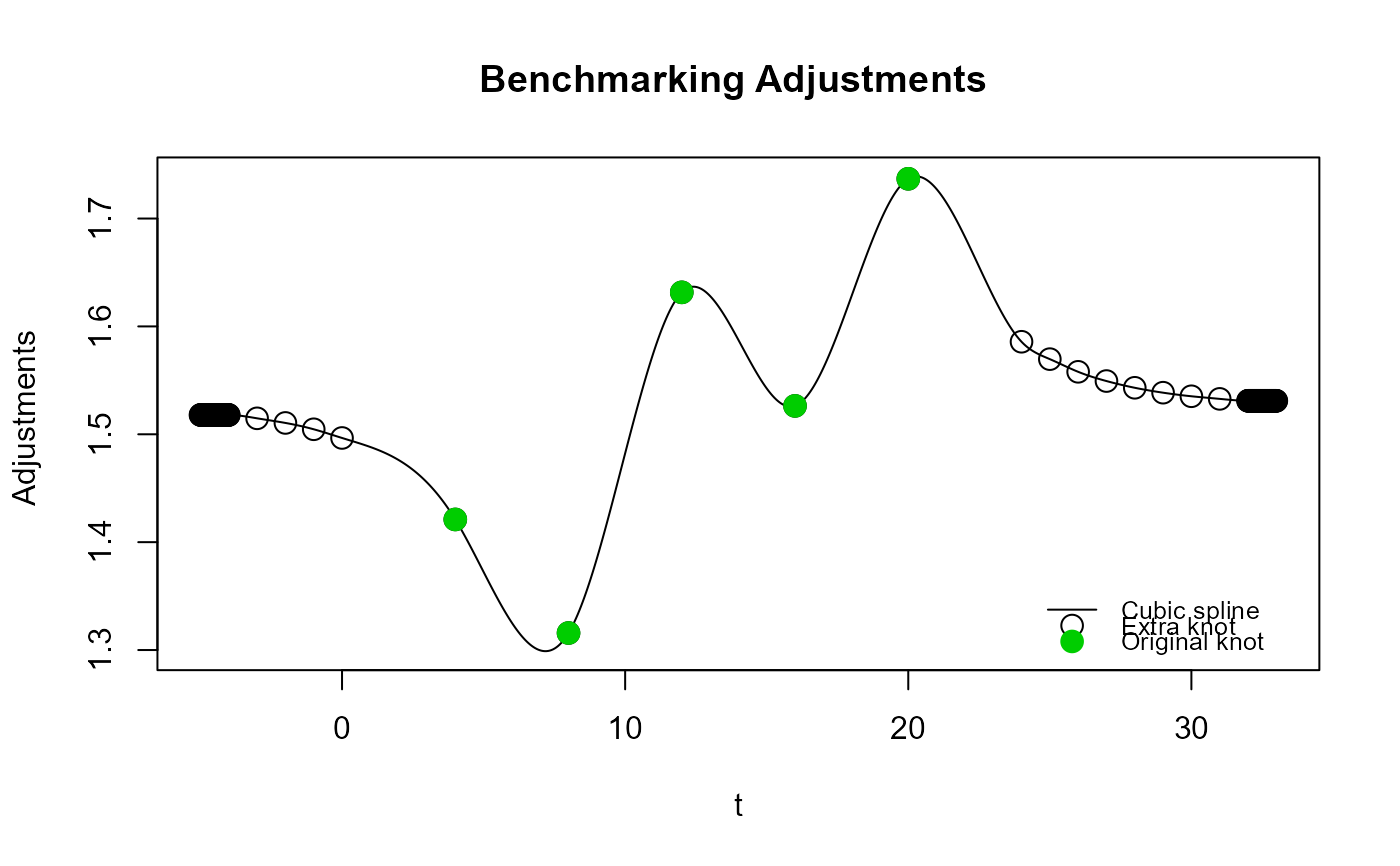Plot benchmarking adjustments for a single series in the current (active) graphics device. Up to three types of adjustments can be overlayed in the same plot:
Adjustments generated by function
benchmarking()Adjustments generated by function
stock_benchmarking()Cubic spline associated to adjustments generated by function
stock_benchmarking()
These plots can be useful to assess the quality of the benchmarking results and compare the adjustments
generated by both benchmarking functions (benchmarking() and stock_benchmarking()) for stock series.
Usage
plot_benchAdj(
PB_graphTable = NULL,
SB_graphTable = NULL,
SB_splineKnots = NULL,
legendPos = "bottomright"
)Arguments
- PB_graphTable
(optional)
Data frame (object of class "data.frame") corresponding to the
benchmarking()(PB for "Proc Benchmarking" approach) function outputgraphTabledata frame. SpecifyNULLnot to include thebenchmarking()adjustments in the plot.Default value is
PB_graphTable = NULL.- SB_graphTable
(optional)
Data frame (object of class "data.frame") corresponding to the
stock_benchmarking()(SB) function outputgraphTabledata frame. SpecifyNULLnot to include thestock_benchmarking()adjustments in the plot.Default value is
SB_graphTable = NULL.- SB_splineKnots
(optional)
Data frame (object of class "data.frame") corresponding to the
stock_benchmarking()(SB) function outputsplineKnotsdata frame. SpecifyNULLnot to include thestock_benchmarking()cubic spline in the plot.Default value is
SB_splineKnots = NULL.- legendPos
(optional)
String (keyword) specifying the location of the legend in the plot. See the description of argument
xin the documentation ofgraphics::legend()for the list of valid keywords. SpecifyNULLnot to include a legend in the plot.Default value is
legendPos = "bottomright".
Details
graphTable data frame (arguments PB_graphTable and SB_graphTable) variables used in the plot:
tfor the x-axis values (t)benchmarkedSubAnnualRatiofor the Stock Bench. (SB) and Proc Bench. (PB) linesbiasfor the Bias line (when \(\rho < 1\))
splineKnots data frame (argument SB_splineKnots) variables used in the plot:
xfor the x-axis values (t)yfor the Cubic spline line and the Extra knot and Original knot pointsextraKnotfor the type of knot (Extra knot vs. Original knot)
See section Value of benchmarking() and stock_benchmarking() for more details on these data frames.
Examples
#######
# Preliminary setup
# Quarterly stocks (same annual pattern repeated for 7 years)
qtr_ts <- ts(rep(c(85, 95, 125, 95), 7), start = c(2013, 1), frequency = 4)
# End-of-year stocks
ann_ts <- ts(c(135, 125, 155, 145, 165), start = 2013, frequency = 1)
# Proportional benchmarking
# ... with `benchmarking()` ("Proc Benchmarking" approach)
out_PB <- benchmarking(
ts_to_tsDF(qtr_ts),
ts_to_bmkDF(ann_ts, discrete_flag = TRUE, alignment = "e", ind_frequency = 4),
rho = 0.729, lambda = 1, biasOption = 3,
quiet = TRUE)
# ... with `stock_benchmarking()`
out_SB <- stock_benchmarking(
ts_to_tsDF(qtr_ts),
ts_to_bmkDF(ann_ts, discrete_flag = TRUE, alignment = "e", ind_frequency = 4),
rho = 0.729, lambda = 1, biasOption = 3,
quiet = TRUE)
#######
# Plot the benchmarking adjustments
# `benchmarking()` adjustments (`out_PB`), without a legend
plot_benchAdj(PB_graphTable = out_PB$graphTable,
legendPos = NULL)
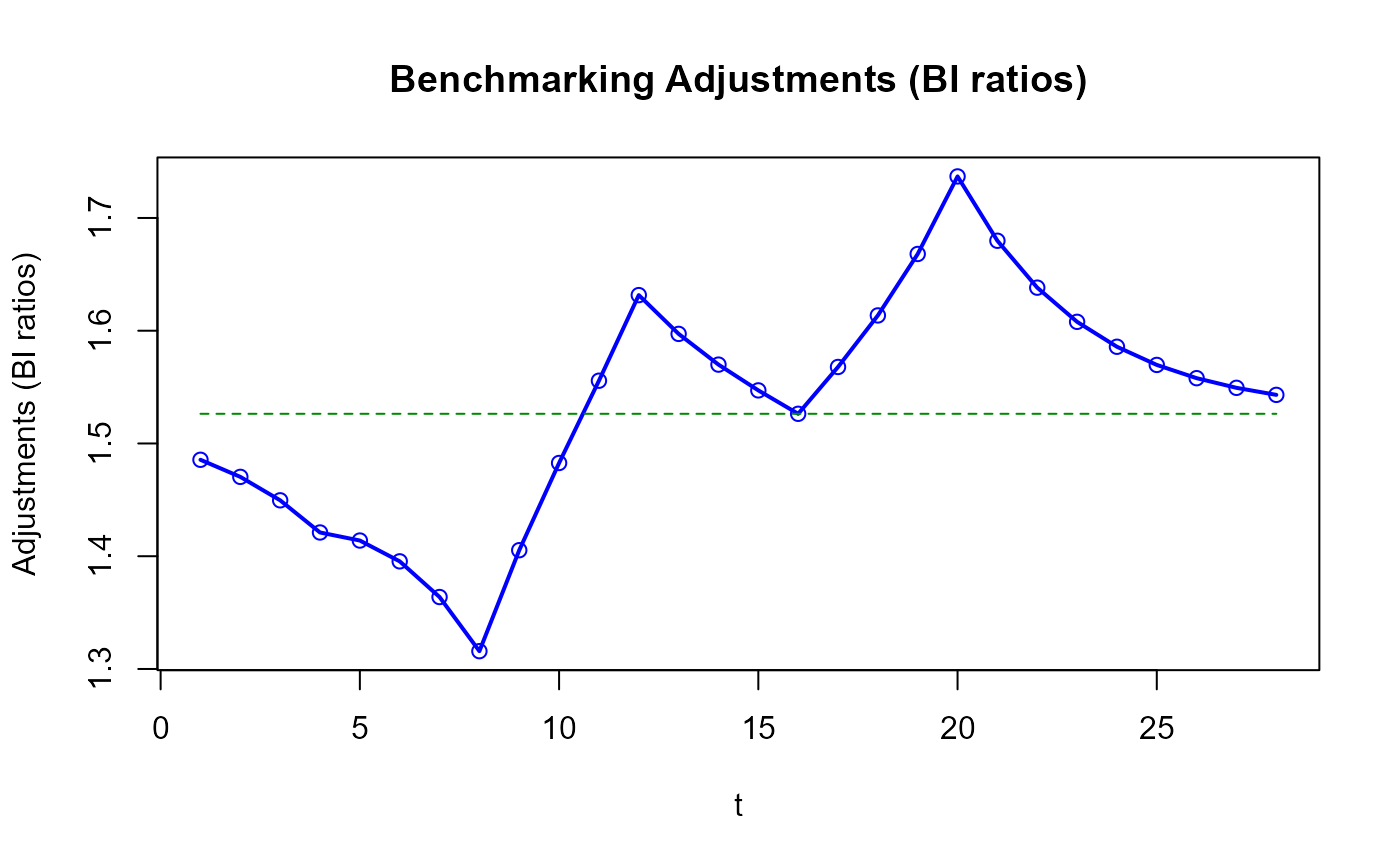 # Add the `stock_benchmarking()` (`out_SB`) adjustments, with a legend this time
plot_benchAdj(PB_graphTable = out_PB$graphTable,
SB_graphTable = out_SB$graphTable)
# Add the `stock_benchmarking()` (`out_SB`) adjustments, with a legend this time
plot_benchAdj(PB_graphTable = out_PB$graphTable,
SB_graphTable = out_SB$graphTable)
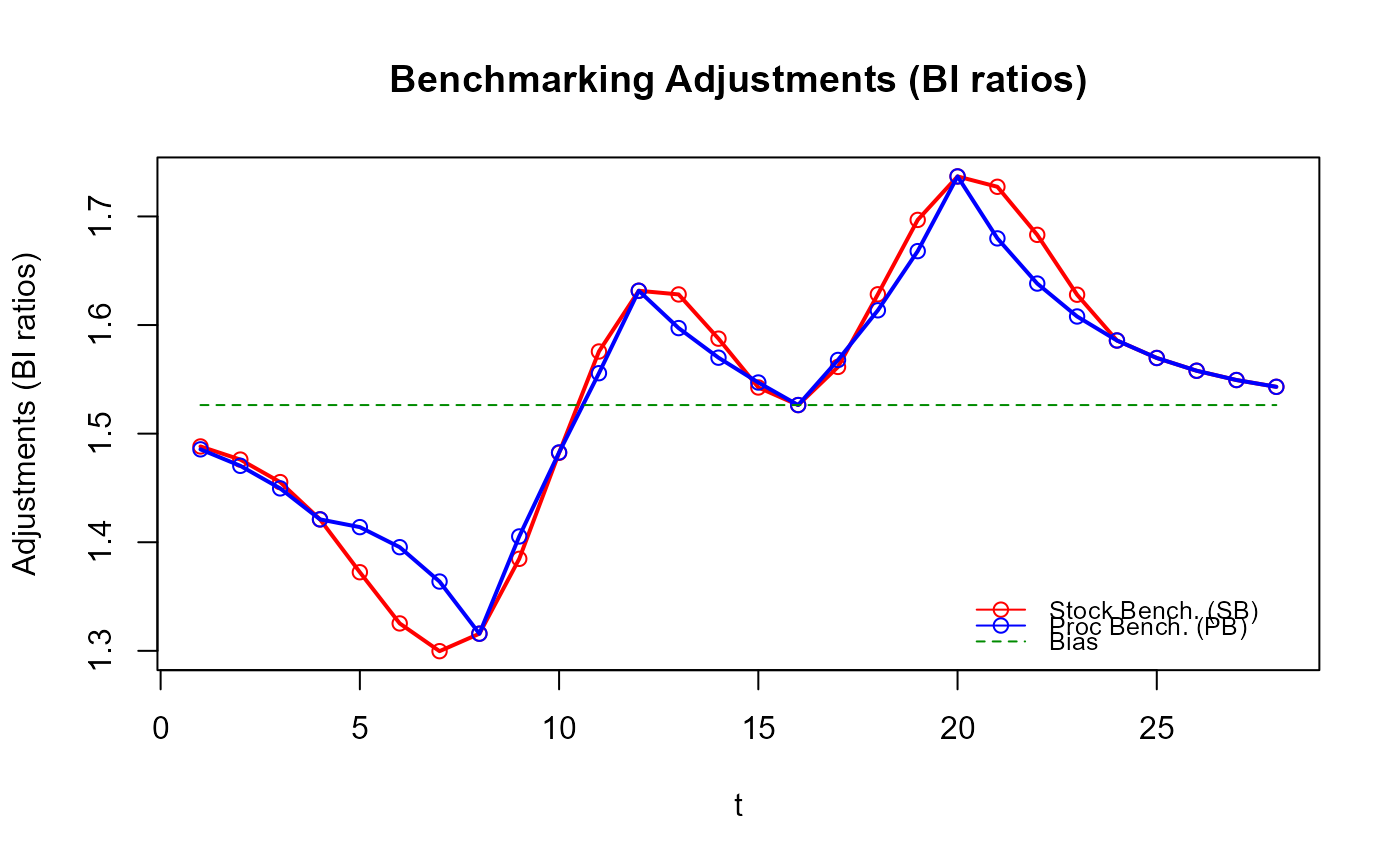 # Add the `stock_benchmarking()` cubic spline actually used to generate the adjustments
# (incl. the extra knots at both ends), with the legend located in the top-left corner
plot_benchAdj(PB_graphTable = out_PB$graphTable,
SB_graphTable = out_SB$graphTable,
SB_splineKnots = out_SB$splineKnots,
legendPos = "topleft")
# Add the `stock_benchmarking()` cubic spline actually used to generate the adjustments
# (incl. the extra knots at both ends), with the legend located in the top-left corner
plot_benchAdj(PB_graphTable = out_PB$graphTable,
SB_graphTable = out_SB$graphTable,
SB_splineKnots = out_SB$splineKnots,
legendPos = "topleft")
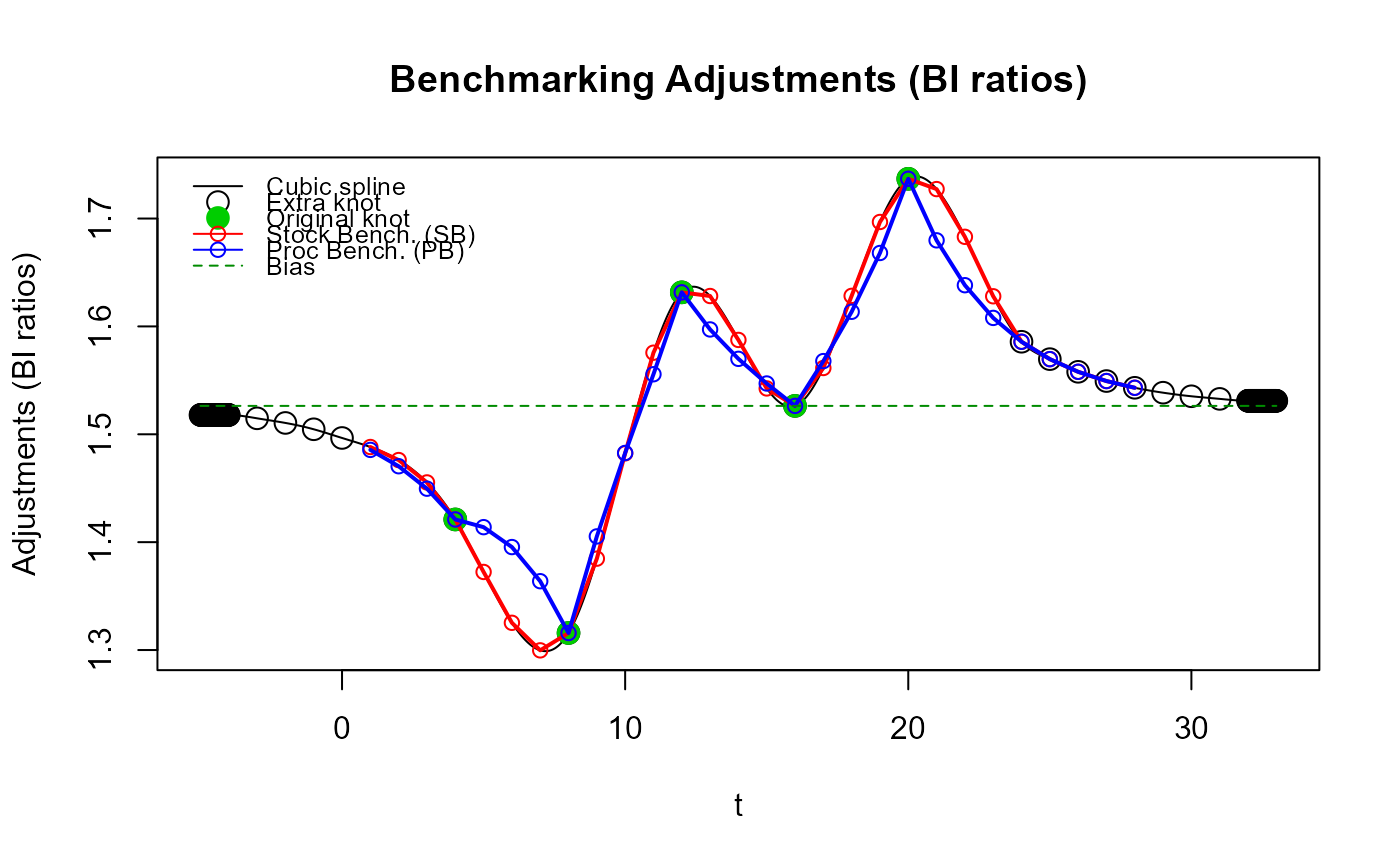 #######
# Simulate multiple series benchmarking (3 stock series)
qtr_mts <- ts.union(ser1 = qtr_ts, ser2 = qtr_ts * 100, ser3 = qtr_ts * 10)
ann_mts <- ts.union(ser1 = ann_ts, ser2 = ann_ts * 100, ser3 = ann_ts * 10)
# Using argument `allCols = TRUE` (identify stocks with column `varSeries`)
out_SB2 <- stock_benchmarking(
ts_to_tsDF(qtr_mts),
ts_to_bmkDF(ann_mts, discrete_flag = TRUE, alignment = "e", ind_frequency = 4),
rho = 0.729, lambda = 1, biasOption = 3,
allCols = TRUE,
quiet = TRUE)
#>
#> Benchmarking indicator series [ser1] with benchmarks [ser1]
#> -----------------------------------------------------------
#>
#> Benchmarking indicator series [ser2] with benchmarks [ser2]
#> -----------------------------------------------------------
#>
#> Benchmarking indicator series [ser3] with benchmarks [ser3]
#> -----------------------------------------------------------
# Adjustments for 2nd stock (ser2)
plot_benchAdj(
SB_graphTable = out_SB2$graphTable[out_SB2$graphTable$varSeries == "ser2", ])
#######
# Simulate multiple series benchmarking (3 stock series)
qtr_mts <- ts.union(ser1 = qtr_ts, ser2 = qtr_ts * 100, ser3 = qtr_ts * 10)
ann_mts <- ts.union(ser1 = ann_ts, ser2 = ann_ts * 100, ser3 = ann_ts * 10)
# Using argument `allCols = TRUE` (identify stocks with column `varSeries`)
out_SB2 <- stock_benchmarking(
ts_to_tsDF(qtr_mts),
ts_to_bmkDF(ann_mts, discrete_flag = TRUE, alignment = "e", ind_frequency = 4),
rho = 0.729, lambda = 1, biasOption = 3,
allCols = TRUE,
quiet = TRUE)
#>
#> Benchmarking indicator series [ser1] with benchmarks [ser1]
#> -----------------------------------------------------------
#>
#> Benchmarking indicator series [ser2] with benchmarks [ser2]
#> -----------------------------------------------------------
#>
#> Benchmarking indicator series [ser3] with benchmarks [ser3]
#> -----------------------------------------------------------
# Adjustments for 2nd stock (ser2)
plot_benchAdj(
SB_graphTable = out_SB2$graphTable[out_SB2$graphTable$varSeries == "ser2", ])
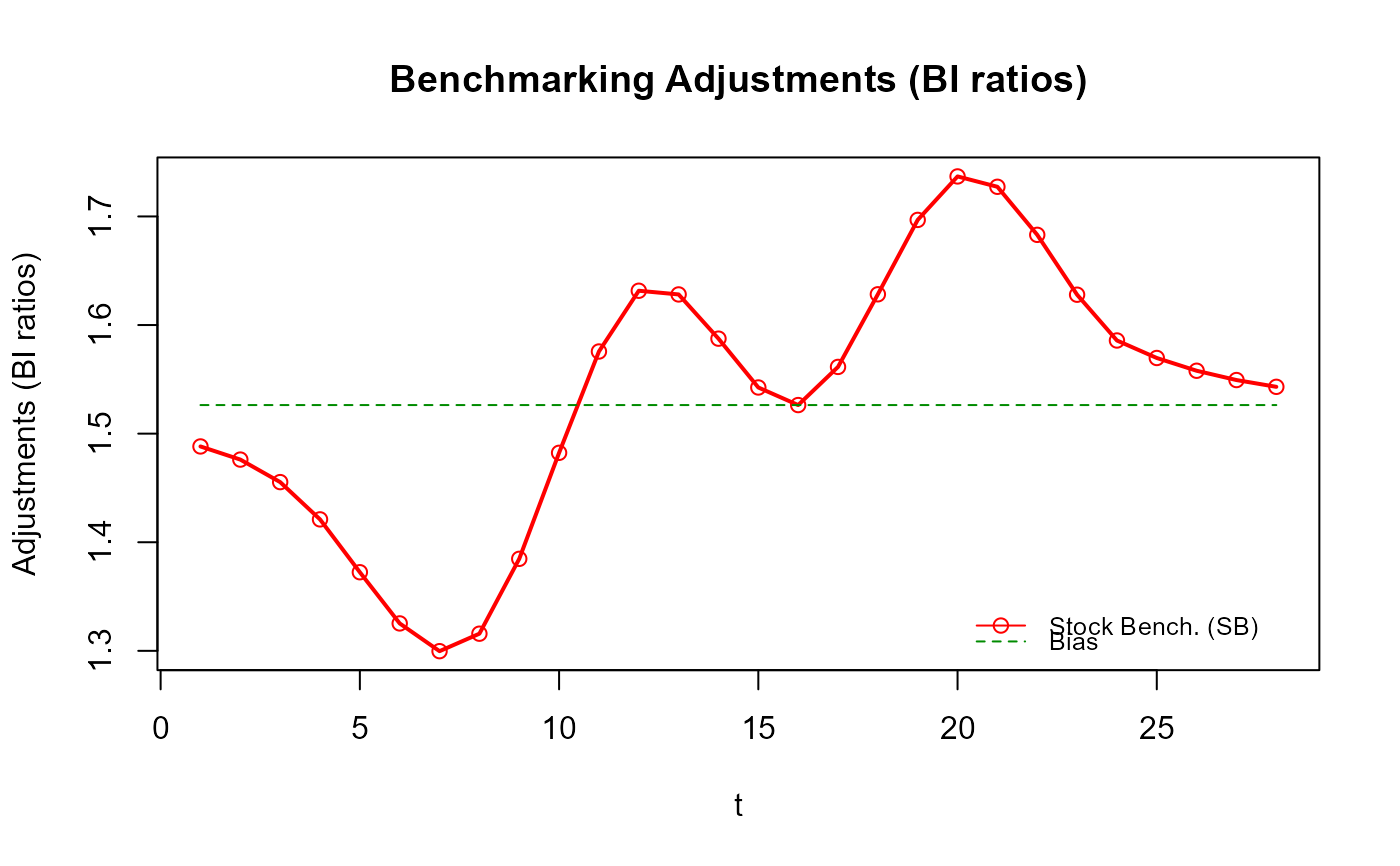 # Using argument `by = "series"` (identify stocks with column `series`)
out_SB3 <- stock_benchmarking(
stack_tsDF(ts_to_tsDF(qtr_mts)),
stack_bmkDF(ts_to_bmkDF(
ann_mts, discrete_flag = TRUE, alignment = "e", ind_frequency = 4)),
rho = 0.729, lambda = 1, biasOption = 3,
by = "series",
quiet = TRUE)
#>
#> Benchmarking by-group 1 (series=ser1)
#> =====================================
#>
#> Benchmarking by-group 2 (series=ser2)
#> =====================================
#>
#> Benchmarking by-group 3 (series=ser3)
#> =====================================
# Cubic spline for 3nd stock (ser3)
plot_benchAdj(
SB_splineKnots = out_SB3$splineKnots[out_SB3$splineKnots$series == "ser3", ])
# Using argument `by = "series"` (identify stocks with column `series`)
out_SB3 <- stock_benchmarking(
stack_tsDF(ts_to_tsDF(qtr_mts)),
stack_bmkDF(ts_to_bmkDF(
ann_mts, discrete_flag = TRUE, alignment = "e", ind_frequency = 4)),
rho = 0.729, lambda = 1, biasOption = 3,
by = "series",
quiet = TRUE)
#>
#> Benchmarking by-group 1 (series=ser1)
#> =====================================
#>
#> Benchmarking by-group 2 (series=ser2)
#> =====================================
#>
#> Benchmarking by-group 3 (series=ser3)
#> =====================================
# Cubic spline for 3nd stock (ser3)
plot_benchAdj(
SB_splineKnots = out_SB3$splineKnots[out_SB3$splineKnots$series == "ser3", ])
